Menus
- From the same beat
- 2 year restoration of the BSA Gold Star DBD 34
- The BSA now has an e-starter
- Honda XBR 500 with "Softie single"?
- Sensible propulsion only from 3500 tours (BSA)
- The Gold Star storms forward at over 5500 rpm
- BSA Gold Star DBD 34 in detail
- Technical specifications
- technology
- Purchase check
- market
- Specialists
- Internet
- Honda XBR 500 / S in detail
- Technical specifications
- technology
- Purchase check
- market
- Specialists
- Internet
- Model variant
- Opinions
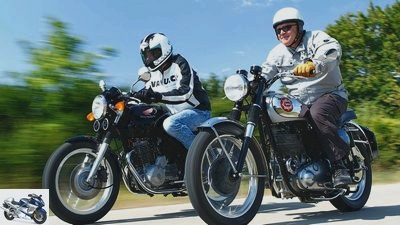
fact / Joachim Schahl
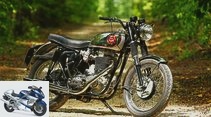
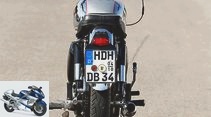
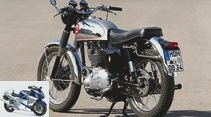

36 photos
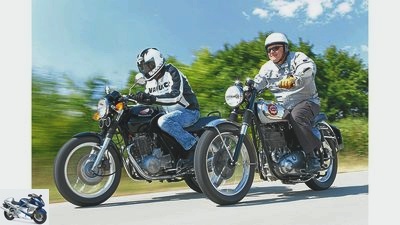
fact, Joachim Schahl
1/36
30 Lenze has already seen Honda’s XBR 500, the BSA can show another 30. Apart from that, they are quite similar.
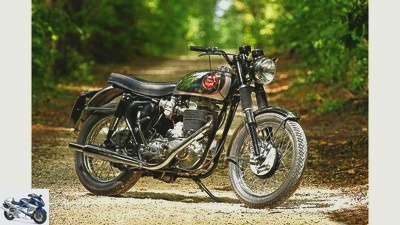
fact, Joachim Schahl
2/36
BSA Gold Star.
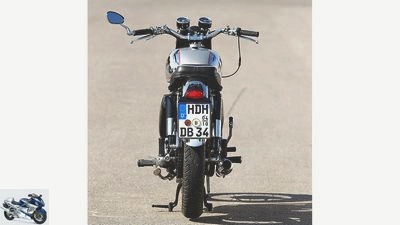
fact, Joachim Schahl
3/36
BSA Gold Star.
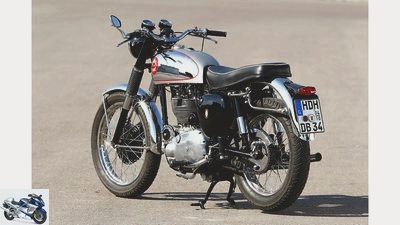
fact, Joachim Schahl
4/36
BSA Gold Star.
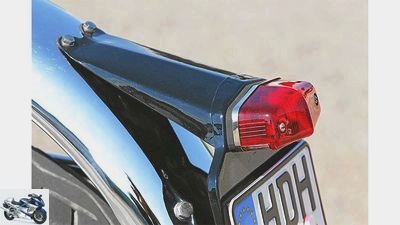
fact, Joachim Schahl
5/36
Simple rear light in a classic style.
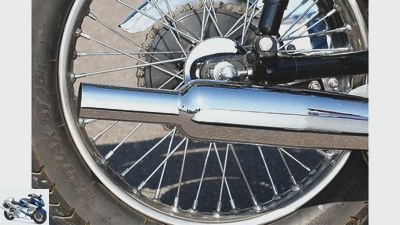
fact, Joachim Schahl
6/36
BSA Gold Star.
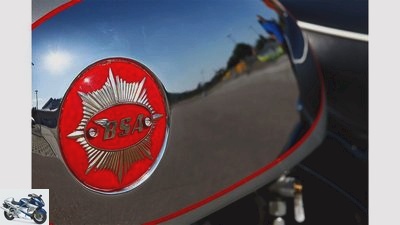
fact, Joachim Schahl
7/36
In demand: machines with the Gold Star emblem on the tank.
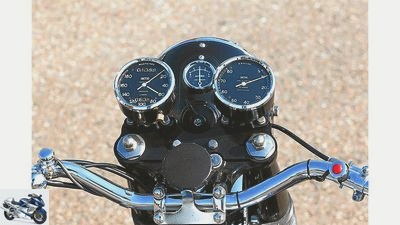
fact, Joachim Schahl
8/36
… The start button is not quite as inconspicuous. The BSA Gold Star was the first production motorcycle to have a complete set of instruments with a speedometer and tachometer.
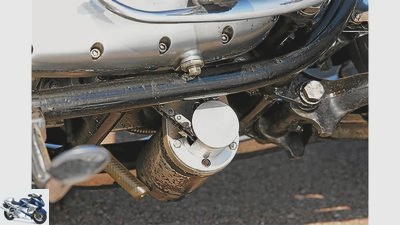
fact, Joachim Schahl
9/36
The retrofitted starter is hidden inconspicuously under the engine, …
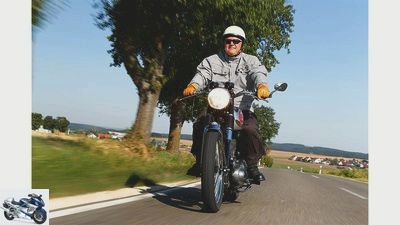
fact, Joachim Schahl
10/36
BSA Gold Star: The sports icon of the 50s embodied with a long-stroke single cylinder and valve control via bumpers …
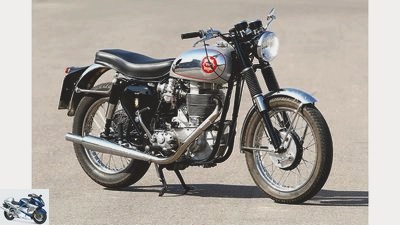
fact, Joachim Schahl
11/36
… classic English motorcycle construction.
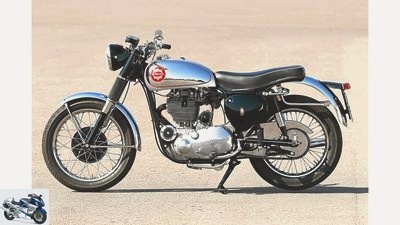
fact, Joachim Schahl
12/36
BSA Gold Star.
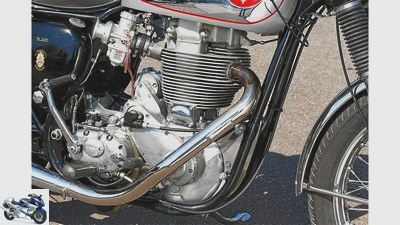
fact, Joachim Schahl
13/36
The sloping elbow is characteristic of the Clubman exhaust, it is only attached to the engine bracket.
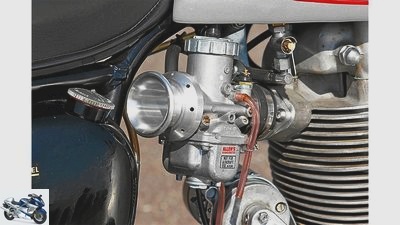
fact, Joachim Schahl
14/36
Instead of the Amal GP carburetor, a non-capricious Mikuni VM 36 takes care of the mixture preparation.
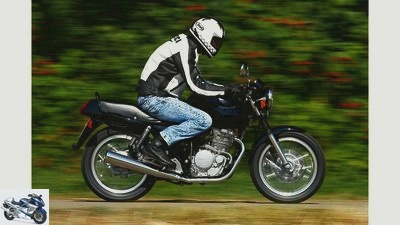
fact, Joachim Schahl
15/36
Honda XBR 500 S..
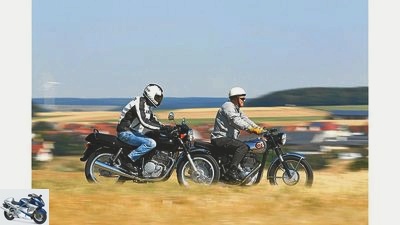
fact, Joachim Schahl
16/36
The curvy the streets, the greater the driving pleasure with the thundering single cylinders.
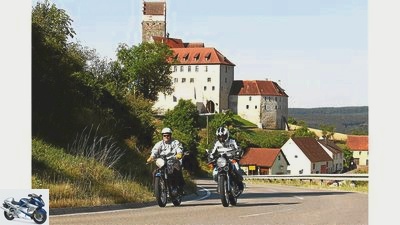
fact, Joachim Schahl
17/36
The two motorcycles are only distinguished by 4 hp.
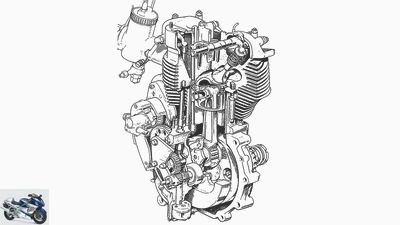
fact, Joachim Schahl
18/36
Despite the simple bumper construction, the DBD 34 achieved a remarkable level of performance.
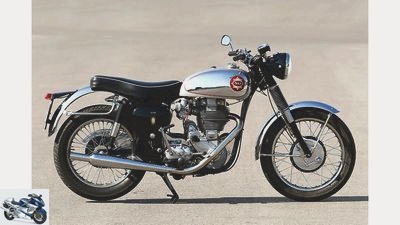
fact, Joachim Schahl
19/36
BSA Gold Star.
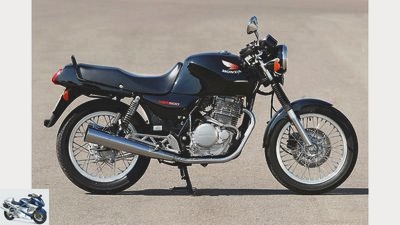
fact, Joachim Schahl
20/36
Honda XBR 500 S..
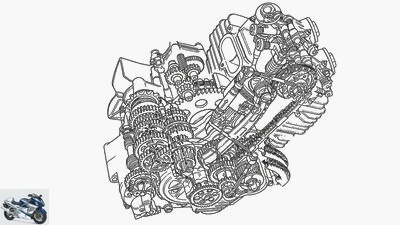
fact, Joachim Schahl
21/36
30 years ago, the Honda XBR 500 with its elaborate radial four-valve head was considered to be the most sophisticated single-cylinder.
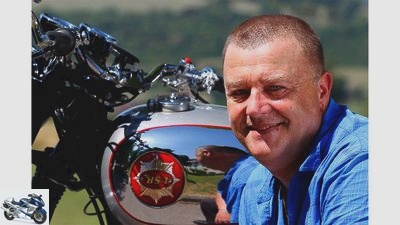
fact, Joachim Schahl
22/36
Martin Krautle, owner of the BSA Gold Star DBD 34:
I like English motorcycles. And above all the BSA Gold Star. For me one of the sportiest single cylinders, and with a character all of its own. The fact that it challenges me as much as I do the Goldie fits perfectly with the sounding driving experience.
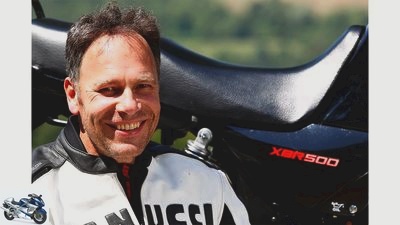
fact, Joachim Schahl
23/36
Uli Holzwarth, owner of the Honda XBR 500 S:
I think the XBR 500 is one of the best all-rounders for small country roads. It drives lively, the technology is stable and the sound is awesome. For me, your fine manners were never an expression of lack of character. It’s a result of progress.
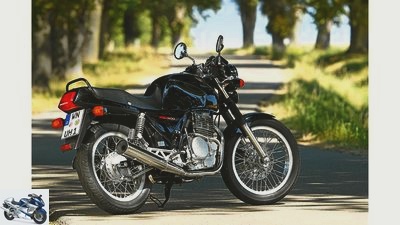
fact, Joachim Schahl
24/36
Honda XBR 500 S..
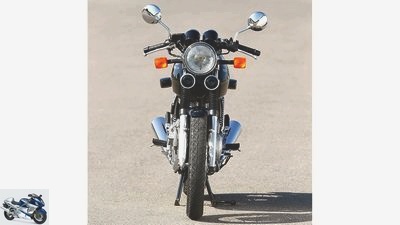
fact, Joachim Schahl
25/36
Honda XBR 500 S..
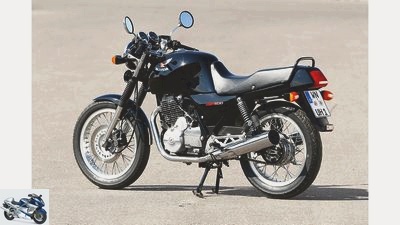
fact, Joachim Schahl
26/36
Judging by its beefy, but rather compact stature, the XBR 500 offers reasonable space even for tall people
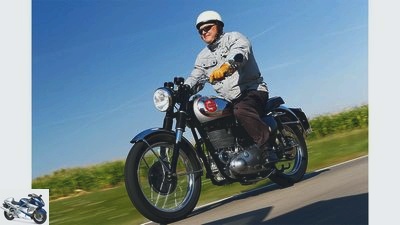
fact, Joachim Schahl
27/36
Despite the age difference, BSA Gold Star and …
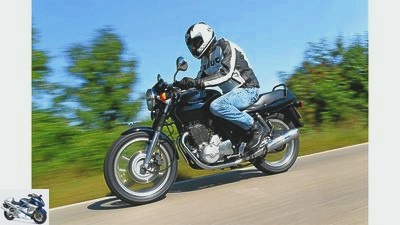
fact, Joachim Schahl
28/36
… the Honda XBR 500 is in the same league in terms of performance.
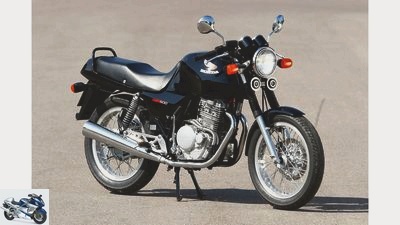
fact, Joachim Schahl
29/36
Honda’s answer to the classic Yamaha SR 500 shows its very own style and is convincing …
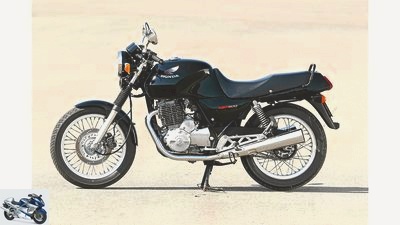
fact, Joachim Schahl
30/36
… with their technically complex and cultivated single cylinder.
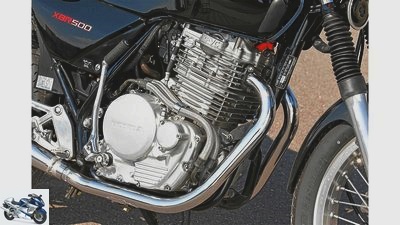
fact, Joachim Schahl
31/36
Honda has also packaged the complex technology of the radial four-valve engine in an attractive manner.
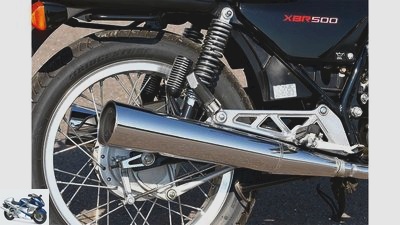
fact, Joachim Schahl
32/36
At the rear, the Honda decelerates via drum brakes while …
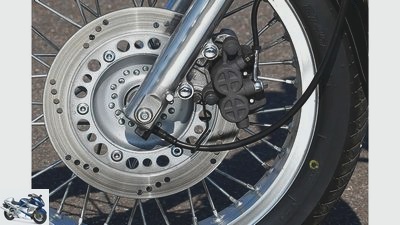
fact, Joachim Schahl
33/36
… an effective disc brake with double-piston floating caliper can be found at the front. The spoke wheels once cost extra.
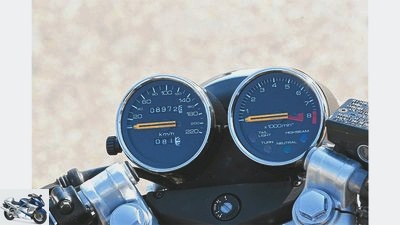
fact, Joachim Schahl
34/36
The speedometer and rev counter present their perfectly legible information in timeless simplicity.
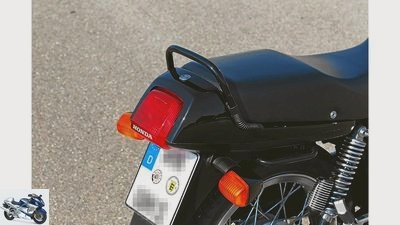
fact, Joachim Schahl
35/36
Rear light with Honda lettering.
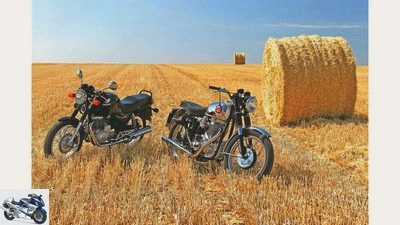
fact, Joachim Schahl
36/36
Honda XBR 500 S and BSA Gold Star.
On the move with BSA Gold Star DBD 34 and Honda XBR 500 S.
From the same beat
Content of
The Honda XBR 500 S celebrates its 30th birthday. Another three decades separate them from their English role model, the BSA Gold Star DBD 34. And yet the two have more in common than just the wonderful one-cylinder stroke.
D.he danger crept slowly and unnoticed up the mountain. Meter by meter, shovel by shovel. When we saw the troop in bright orange, it was already too late, the road maintenance brigade had already covered the narrow driveway to Dischingen Castle an inch thick with gravel.
Buy complete article
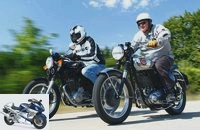
On the move with BSA Gold Star DBD 34 and Honda XBR 500 S.
From the same beat
BSA Gold Star DBD 34 would not only lack the kick, but also the true role model of the XBR 500. Honda had certainly taken a close look at the British sports icon of the 50s when it was considered that Yamaha’s bestseller SR 500 was a sporty one To oppose single cylinder. The 1985 not the style, but the tradition of a BSA Gold Star revived.
2 year restoration of the BSA Gold Star DBD 34
Its story began on June 30, 1937, when a certain Walter Handley won the three-hour race on the Brooklands Railway on a specially prepared BSA Empire Star with an average speed of 165 km / h and won a small pin with the Gold Star as an award. By the end of the fast single cylinder in 1963, the steadily improved and strengthened Gold Star models had dominated the scene of the English production machine races. Not only in road races, but also in motocross and trial competitions as well as in many track races, the BSA single-cylinder achieved countless victories. A special feature was that the machines – depending on the customer’s requirements and purpose – were built individually, so that hardly any Gold Star was like the other. That didn’t change the fact that a Gold Star became a cult motorcycle, the prices of which have now reached a remarkable level.
Martin’s “gold piece” wasn’t cheap either. He had his BSA Gold Star DBD 34, built in 1958, completely rebuilt by the German BSA specialist Herbert “Hebsch” Schusseler. It was the first time that the engineer did not tackle such a restoration himself because he was restoring two Ariel Red Hunters at the same time. The Swabian had to be patient for almost two years before he could finally pick up his dream motorcycle in Schophoven in the late summer of last year.
The BSA now has an e-starter
But the wait was worth it, the BSA Gold Star DBD 34 bewitches in the glaring sunlight with its classic shapes. And a sound spectacle, the pressure waves of which make my trouser legs flutter strongly from a distance. It’s a raw, uncouth rumbling and barking that makes small children run away screaming – and pulls the corners of my mouth up to my earlobes. Little cushioning, lots of emotion – it used to be that simple. Honda’s sound engineers didn’t have it that easy in the mid-80s, but despite the more restrictive noise limits they succeeded so well with the pithy, dull thud that XBR fans still find it a big part of the fascination of this Japanese single.
At the moment, however, Martin’s BSA Gold Star DBD 34 fascinates me much more, and not just in terms of onomatopoeia. Like most of the former factory customers, the 49-year-old also had his DBD 34 built according to his wishes. This also includes the Clubman package, which, in addition to the conical chrome bag with the sloping exhaust manifold, also includes sharp camshafts, higher compression and a large carburetor with an open intake funnel. Instead of the original Amal GP, however, Martin opted for a less capricious Mikuni carburetor. The modified Triumph clutch with aluminum basket and four pressure springs as well as a red button on the right handlebar fitting are also not original! Martin grins when he becomes aware of my amazement. “Yes, last winter I actually installed an electric starter that Phil Pearson sells in England. After all, I want to drive my Gold Star for a very long time, so an inconspicuous electric starter is a great thing! ”For this reason, Martin has also done without steering stubs and set back notches. Enough looked. Martin jumps up and shoots ahead in a typical English gentleman rider’s posture, massaging my diaphragm.
Honda XBR 500 with "Softie single"?
On my Honda XBR 500 S, on the other hand, I sit much more gathered. First of all, I’m glad I got it up and running in time. Three weeks earlier I had regretted my spontaneous purchase on the phone – when I handed it over to the autobahn, the black spoked wheel version looked really miserable. It took around 50 hours of work, then the traces of the 13-year service life were at least somewhat removed and the carburetor was fit again after two ultrasonic baths. Nevertheless, the appointment with the BSA would almost have been missed in the last second if Choice from Mainjet, the technology guru of the XBR forum (www.xbr.de), hadn’t sent me his clutch cable in a lightning action overnight – thanks again!
So I follow the carpet of sound that Martin is laying out in front of me and get to know my “new” Honda XBR 500 S on the first extended drive. Fortunately, the radial four-valve engine with electric and kick starter doesn’t bite around. On the contrary: The short-stroke hangs wonderfully on the accelerator, pulls forward smoothly from 2000 tours without jerking or even hoeing, even in fifth gear of the precise transmission. Vibrations are hardly noticeable up to around 5000 rpm, only then does the fingers tingle subtly. But then there really comes to life in the pot, which energetically turns over 4500 rpm into the red area and acoustically does not hide the fact that many parts are moved in its elaborate cylinder head. All in all, an extremely harmonious single cylinder with a wide usable speed range, which the gnarled MOTORRAD veteran Peter Limmert called a “softie single” in the first test in issue 11/1985 and even accused him of a certain lack of character.
However, this was not the reason that the production of the Honda XBR 500 was stopped in 1988 and that only remnants were sold until 1990, mostly with spoked wheels in the end. Because on its debut in 1985, the XBR encountered a motorcycle scene that relied less on tradition, but rather hungered for performance and sportiness. By the end of 1990, only around 8,000 single-cylinder fans were therefore able to warm to the XBR 500. I bet there are more today. Because despite the striving for perfection, the Honda single also transports the feeling of original motorcycling very convincingly into the hectic here and now. It is simply wonderful how stress-free the single can drift along the winding streets of the second and third order. Once you get used to the somewhat idiosyncratic steering behavior due to the flat steering head angle and keep the Honda on the pull when you flip it, it whizzes through the radii precisely and extremely light-footed. When the fork oil level is raised (air chamber 140 millimeters), it swallows even coarser waves and frost breaks with ease. The front disc brake grips easily, effectively supported by the inconspicuous rear drum. With its 44 hp, the XBR is sufficiently motorized for great fun on such small fictional streets. That can also last, because the 19 liter fuel tank allows the tank intervals to be extended to over 400 kilometers. A distance that even tall pilots cover in a surprisingly comfortable manner on the neatly padded bench.
Sensible propulsion only from 3500 tours (BSA)
Break. Now Martin risks more than just a look at the Honda XBR 500 S, after his thumbs up on the country road earlier, because I gave him the leather every time I pulled through. A small weakness that the BSA fan forgives his Gold Star because he consciously opted for the original, very long racing translation. With the sharp Clubman camshafts and the wide spread of the somewhat stubborn four-speed gearbox, not the purest pleasure on narrow country roads, as I notice from the first few meters. At this point, I would also like to thank Martin for having entrusted me with his gold piece without reservation, even though it has only run 1200 kilometers since the rebuild and has therefore “not yet fully retracted”.
So I take it easy at first, after all I’m sitting on a motorcycle legend that is almost 60 years old. I don’t find the very comfortable upright posture at all old-fashioned, as if made for enjoyable kilometers. Great knee grip on the tank, good seating comfort – this is how you make friends! Thanks to the soft, easy-to-dose clutch, starting off is easy. With my nose in the wind and one eye on the wonderful Smith’s instruments – the Gold Star was one of the first motorcycles with a speedometer and rev counter ex works – I promptly fall into the gearbox trap. Much too early, I put in the third, in which the long stroke now almost starved at 2500 rpm. After all, the concentricity is much better than I imagined after Martin’s descriptions, even the BSA Gold Star DBD 34 does not hack if you gently pull up the sickly sipping Mikuni. However, there is only reasonable propulsion from around 3500 tours. So press the tip of your right foot consistently upwards and drive the single up to the 5000 mark in second gear. With increasing speeds, the vibrations also increase, but without affecting my well-being too much.
The Gold Star storms forward at over 5500 rpm
Lo and behold, the connection in the third fits better, the BSA Gold Star DBD 34 is picking up speed, accompanied by the unbelievable rumble of thunder from the conical cannon barrel. Initially, this distracts me so much that I need a few kilometers before I am aware of the impeccable handling properties of the Gold Star. Yes, actually, the BSA turns in easily and effortlessly, even at high country road speeds, without appearing nervous. At the entrance to the bend, the BSA with Bridgestone BT 45 tires whizzes completely neutrally in an inclined position, like the Honda, there is no noticeable tendency to collapse like the Honda XBR 500 S. The Gold Star rides perfectly on smooth asphalt for a bike from the 1950s. On more undulating passages, however, the stern in particular begins to vibrate, and the damping aft is not the best. In the front, Martin der Gabel has given Eddie Dow inserts, which are not so spontaneously animated to sway by asphalt faults.
So I tick off this exhilarating experience and head for a clean tarred route. Now it’s true: Martin allowed me to drive the tachometer needle past the 6000 mark at least once to get an impression of the true character of the BSA Gold Star DBD 34 in Clubman trim. In fact, as soon as the needle passes over 5500 rpm, the lulling, good-natured composure is over. Accompanied by infernal drumming and greedy aspiration, the Gold Star storms on as if it had shaken off an annoying passenger! It feels more powerful than the evenly turning short stroke of the Honda, but the two half-liter singles shouldn’t give each other anything with almost the same performance. However, the BSA pilot has to work a lot more, be it accelerating or braking with the toothless and powerful drums.
Martin is aware of this, he just likes it when the driver is challenged as much as the motorcycle. He has his BSA Gold Star DBD 34 again and is waving. I follow him into the Winkelwerk – before the cobblers in bright orange spoil our fun again.
BSA Gold Star DBD 34 in detail
fact, Joachim Schahl
BSA Gold Star DBD 34
Technical specifications
Engine:
air-cooled single-cylinder four-stroke engine, two camshafts below, two valves, actuated via tappets, bumpers and rocker arms, bore x stroke 85 x 88 mm, displacement 499 cm³, output 29.4 kW (40 hp) at 7000 / min
Power transmission:
Multi-disc clutch, four-speed gearbox, chain drive
Landing gear:
Double loop frame made of tubular steel with a single top tube, telescopic fork, Ø 39 mm, two-arm swing arm, two spring struts, wire-spoke wheels, tires 3.25 x 19 front, 3.50 x 19 (4.00 x 18) rear, drum brake front, Ø 190 mm, drum brake rear, Ø 170 mm
Measurements and weight:
Wheelbase 1422 mm, weight 165 kg with a full tank
Top speed:
180 km / h
technology
fact, Joachim Schahl
Despite the simple bumper construction, the BSA Gold Star DBD 34 achieved a remarkable level of performance.
With the DBD 34, BSA opened the last chapter in the successful Gold Star story in 1956, which began in 1937 with a victory in a three-hour race. The following year, BSA, until then not exactly known for sporty motorcycles, launched the M24 Gold Star, a revised half-liter model with 28 hp. It was one of the first production motorcycles with an aluminum cylinder and head.
After the war, the Gold Star program really took off in 1948. First with the 350 ZB32, followed the following year by the half-liter version ZB34 with an aluminum engine, the stroke of 88 millimeters and the bore of 85 millimeters remained identical in all successor models. Likewise, the basically classic British structure with two camshafts below, which actuated the two valves via tappets, bumpers and rocker arms, as well as a separately flanged four-speed gearbox. Otherwise, however, a Gold Star was freely configurable by the customer, be it as an off-road athlete, trialer, track or road racer. In order to meet all these requirements, different pistons, compression ratios, frames and gear ratios were available, as well as a lighting system and road equipment.
From 1952, the Gold Star got a new cylinder head with a separate rocker arm housing, and for 1953 a frame with double girders and a rear swing arm. The designation was BB34 for the 500. Their engine was even less ribbed, while from 1954 half-liter engines with reinforced housing and crank drive, lush ribbing and five instead of four tie rods and the designation CB34 supplemented the range.
For 1955, the single underwent a further revision of the head and crank drive, and it again had four cylinder tie rods. The designation: DB34. For the 1956 model year, the model flood was eliminated, leaving the 500 Gold Star types DBD 34 in a Clubman variant and as a racing machine. The difference to the DB34 engine was made by a large Amal GP carburetor with an enlarged bolt spacing on the intake port, which was also enlarged. From then on, the 350 variants, which had always been offered in parallel, were only available to order.
Purchase check
The BSA Gold Star models were built primarily for amateur races, in which they did very successfully in the 1950s. When buying a Gold Star, one should always be aware that a sporty single-cylinder, whether on the road, off-road or in competition, can offer potential buyers many surprises in terms of wear and tear. Especially since the crank drive, especially the two crank pins, was not exactly oversized for high continuous speeds.
The cylinder, piston and head are considered to be quite robust, in contrast to the rapidly wearing chain of the primary drive. However, most of the BSA Gold Star DBD 34s offered today have already had one or more overhauls behind them. It should be noted that there are not only big differences among the “specialists”, but also in the quality of the replacement and replica parts. Therefore, it is best to visit a Gold Star only with a proven expert on the scene, who also knows how to classify engine and frame numbers.
market
fact, Joachim Schahl
In demand: machines with the Gold Star emblem on the tank.
Of all the Gold Star types, the powerful DBD 34 types are among the most sought-after today if they are also to be used in road traffic. A BSA Gold Star DBD 34 is one of the sought-after icons of the classic scene, which is why prospective buyers have to expect prices that are significantly higher than those of the stronger twins. For good copies, around 15,000 euros are to be invested. In the case of a top restoration by a recognized Gold Star specialist and a traceable history of the motorcycle, you can confidently add another 5000 euros. Even run-down restoration objects are hardly available for less than 6000 euros.
Specialists
Herbert Schusseler
www.bikersmill.de
Jorg Niemeyer, single & Twin
www.singleandtwin.de
Phil Pearson
www.bsagoldstar.co.uk
Jan de Jong (parts, replicas)
www.absaf.nl
Internet
BSA Owners Club
www.bsa-oc.de
Honda XBR 500 / S in detail
fact, Joachim Schahl
Honda XBR 500 / S (1985-1990)
Technical specifications
Engine:
air-cooled single-cylinder four-stroke engine, one overhead camshaft, four valves per cylinder, operated by rocker arms and rocker arms, bore x stroke 92 x 75 mm, displacement 498 cm³, power 32 kW (44 hp) at 7000 rpm
Power transmission:
Multi-disc oil bath clutch, five-speed gearbox, chain drive
Landing gear:
Single tube frame made of tubular steel with forked support, telescopic fork, Ø 35 mm, two-arm swing arm made of box profiles, two spring struts, wire-spoke wheels with aluminum rims, tires 100 / 90-18 at the front, 110 / 90-18 at the rear, disc brake at the front, Ø 274 mm, double-piston Floating caliper, rear drum brake
Measurements and weight:
Wheelbase 1400 mm, weight with a full tank 182 kg
Top speed:
175 km / h
technology
fact, Joachim Schahl
30 years ago, the Honda XBR 500 with its elaborate radial four-valve head was considered to be the most sophisticated single-cylinder.
Honda’s elaborate radial four-valve single made its debut in 1983 in the off-road models XR 500 and XL 600 R. For the half-liter street variant, which also has dry sump lubrication with a separate oil tank, the technicians gave the single-cylinder a crankshaft with a larger flywheel, smaller valves and a 39 mm constant pressure carburetor instead of two coupled mixture formers.
A balance shaft driven by gear wheels, which rotates in front of the crankshaft, eliminates at least the coarse vibrations typical of a large-volume single cylinder very effectively. In contrast to the studded wheels, Honda has given the XBR 500 not only a kick starter but also a comfortable electric starter. The result of the revision was convincing from a technical point of view across the board. Because in the street model, the short-stroke turned out to be a remarkably cultivated single, who even in fifth gear from 2000 rpm can take the gas jerk-free and willingly let it turn to the red area without shaking the seals out of your teeth.
Purchase check
Among its peers, the radial four-valve engine is one of the extremely durable single-cylinders that, with good care, can achieve nearly six-figure mileage without major overhauls. However, regular oil changes and meticulous checks of the oil level and valve clearance are required. Taken hard, the single cylinder can pull in up to one liter of the lubricant per 1000 kilometers – with correspondingly serious consequences for negligent tormentors, since the total oil content is just under two liters. With the first models there were often sheared starter freewheels to complain about because the engine of the Honda XBR 500 “ran after” after being switched off because of the high flywheel mass. In 1986, Honda responded by installing a torque limiter, recognizable by the bump above the starter housing.
Further known weaknesses of the Honda XBR 500 are torn off left retaining screws of the oil tank. As a result, the spacer bushing between the chain and the pinion could fall off if it was lost. A well-known phenomenon, especially with XBR from the first years of construction, are still cracks in the cylinder head between the plug hole and (especially) the exhaust valves. At first this is not tragic as long as there is no consequential damage with valve seats falling out. Interested parties should also know that the models that were throttled to 27 HP by camshaft until 1987 can only be brought to 44 HP with great effort. The camshaft required for this is only available second-hand (expensive!), And the accessories trade does not offer a directly suitable alternative either.
From 1988 (chassis numbers starting with PC15-53, -71, -63 and -81) the Honda XBR 500 received a camshaft with an automatic decompression device, the power reduction has since been carried out via a narrowed intake manifold and adapted spraying, which enables cost-effective dethrottling. Other typical, but easy to spot, XBR malaises are worn out swing arm bearings and main stand axles, jammed sliding pins on the floating caliper of the disc brake or broken retaining lugs on the side covers.
market
While the GB 500 Clubman based on the Honda XBR 500 has long been traded at enthusiast prices, the tariffs for good XBR 500 have been increasing significantly for some time. In particular, spoked wheel variants are sought that either already produce 44 hp or can simply be dethrottled via the intake manifold. For such – now rare – first-hand copies in top condition with mileages of less than 20,000 kilometers, prices of 3000 euros and more are paid today, while decent 27 hp variants from the first years of construction are still available for around half. Still, since the increasing tendency cannot be overlooked – under 1000 euros there is almost only scrap.
Specialists
MainJet
www.mainjet.de
Internet
Top forum for XBR / GB
www.xbr.de
Model variant
mps photo studio
Honda GB 500 Clubman
Honda GB 500 Clubman (PC16): The Clubman intended for the USA but flopped there is the nostalgic version of the Honda XBR 500 with 38 hp. Came to us via detours, from 1992 even through the official importer. Very sought after today. Price 1992: 7,760 marks.
Opinions
fact, Joachim Schahl
A brief statement about the two bikes.
fact, Joachim Schahl
Uli Holzwarth, owner of the Honda XBR 500 S..
I think the Honda XBR 500 S is one of the best all-rounders for small country roads. It drives lively, the technology is stable and the sound is awesome. For me, your fine manners were never an expression of lack of character. It’s a result of progress.
fact, Joachim Schahl
Martin Krautle, owner of the BSA Gold Star DBD 34.
I like English motorcycles. And above all on the BSA Gold Star DBD 34. For me one of the sportiest single cylinders, and with a very own character. The fact that it challenges me as much as I do the Goldie fits perfectly with the sounding driving experience.
Related articles
-
Honda GL 1000 Gold Wing and Munch-4 TTS-E 1200
fact 35 photos fact 1/35 Honda GL 1000 Gold Wing and Munch-4 TTS-E 1200. fact 2/35 Nevertheless, the Munch is not as inaccessible as feared. In fact, she…
-
Honda Gold Wing GL 1800 endurance test final balance
Jacek Bilski 34 photos ADAC 1/34 I’ve never taken apart an engine that looked this good, everything here looks more like 5,000 than 63,000 kilometers….
-
Comparison test Yamaha Drag Star – Honda Shadow
Comparison test Yamaha Drag Star / Honda Shadow soft parts If you want to be tough, you have to have soft parts: Long after the Honda VT 600 Shadow got the …
-
Klaus H. Daams 26 pictures Klaus H. Daams 1/26 This is where motorcycle history meets. Klaus H. Daams 2/26 “LTD” insignia: Maroon paint, golden rims …
-
Comparative test of the BMW K 1200 TL against the Honda Gold Wing GL 1500 SE
Comparison test BMW K 1200 TL against Honda Gold Wing GL 1500 SE Welcome “Wos d´Japana kenna, des kenna mia scho lang”, the Bavarian mumbled and …
-
Driving report Honda Gold Wing
Driving report Honda Gold Wing Great goodness Oh dear, now the time has come! 1.8 liter displacement, price just under 50,000 marks. The only thing…
-
fact 12th photos fact 1/12 Top brakes: radially screwed six-piston stoppers, ABS and integral actuation. fact 2/12 Builds compact and very narrow: the…
-
Honda CB 750 Four, Munch-4 1200 TTS, MV Agusta 750 S.
Jahn 33 photos Jahn 1/33 It couldn’t be any more engine: with its transversely installed four-cylinder in-line engine, the Honda CB 750 caused a…
-
On the move with the Honda GL 1000 Gold Wing
Jahn 11 photos Jahn 1/11 In view of the enlightening driving impressions with the Honda Gold Wing from 1977, some old prejudices have to be straightened…
-
Cult bike Honda GL 1000 Gold Wing
Archive 6 pictures Markus Jahn 1/6 Markus Jahn 2/6 Honda 3/6 Travel motorcycle with smooth running and comfort: the Honda GL 1000 Gold Wing from 1974. Archive 4/6 With …